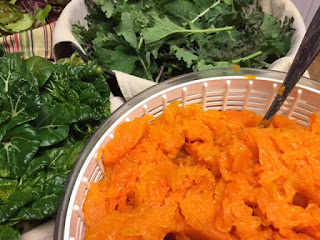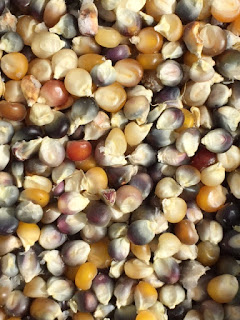We almost missed it. A small white sign with blue letters, leaning precariously to one side, held in place with spindly wire rods stuck into earth along the highway's shoulder. One of thousands of its kind, scattered along NC roadways, advertising everything from yard sales to income tax assistance services and easily ignored, but, for some reason, this one caught attention.
"Did that say something about crab?" Richard asked.
Before I could reply, another sign followed the first. "Crab Feast!" Richard exclaimed.
It was the word "feast" that cinched our decision to leave our planned route and take a small two-lane road that bisected miles of burned forest land in search of the event. "Festival" probably would not offer the same enticement, but "feast," with images of Thanksgiving, passed plates of delicious foods and aromatic cooking smells made us detour our journey home to take an unfamiliar drive to a place we never heard of. Besides, we were hungry.
 |
| Road construction almost hid the town's directional sign |
When we turned into the small village of Stumpy Point, it was like driving back in time. A single, two-lane road meandered along a picturesque body of water, punctuated by neat homes. Arriving at a small community center, which seemed to be bustling with activity, we parked across the street near a Methodist church which reflected bright afternoon sunlight and stood, brilliantly white, against October blue sky. As we approached the community center, next door to the Volunteer Fire Department, host to the Crab Feast, we were welcomed by warm smiles and friendly greetings. A tall man took us under his wing and led us into the community center, eager to tell us about the Crab Feast after we explained we had never attended one before, but were led to his town after reading the signs along the highway. From his surprised expression, we guessed not many other travelers made the trek.
After we purchased tickets, two volunteers stamped our hands and the man who ushered us inside told the women, "These people are not from around here. They saw the signs at the highway and decided to come." Perhaps there was no hidden message in his statement, but I wondered if those signs were his idea or maybe there had been some discussion among the townspeople about the effectiveness of posting signs. At any rate, the volunteers directed us to a buffet of fresh local food with encouragement to "stay as long as you like and eat as much as you want!"
Servers ladled steaming crab stew, carefully adding half a crab, dumplings, potatoes, celery and rich broth to each bowl. Fried crabs followed the stew, broken in half to make picking the sweet meat easier. Cole slaw and baked beans were next and then hushpuppies and fresh local fish, battered and fried just beyond the serving line by a man who worked expertly and efficiently in a small space. Drink choices were both kinds of tea, sweet and unsweet, and Richard and I juggled bowls, plates and cups as we made our way to an outdoor picnic table where a couple moved to make room for us.
 |
| The Point at Stumpy Point, NC |
We chatted with the local fisherman and his companion while dredging the succulent fish in a tangy sauce. When I tasted the stew, I sighed. "Good, right? Everybody loves that stew." The fisherman nodded as I spooned the goodness in what I hoped was a not-too-indecent pace. We noticed our nearby dining companions were expertly removing tiny bits of crab meat from the fried shells, but I am afraid we were a bit wasteful, owing to inexperience. Still, the bites we retrieved were nothing short of delightful. After eating our fill from the buffet, we made our way to the VFD building where a helpful greeter told us to "sit where ever you like and someone will bring you steamed crabs." Really? That simply, these people stole our hearts.
 |
| A tray of fresh, steamed crabs |
The tray of steamed crabs was delivered, as promised, and a young woman gave us a quick lesson in how to break open crabs, seek sweet meat from hiding places and crack claws with a round wooden mallet. Using our fingers to dip the tender bites in drawn butter before popping them in our mouths, we enjoyed as much as we could before, regretfully, admitting defeat and stopping to wash our hands (and faces) in preparation for the trip home to western NC.
Before driving away, we stopped to chat with a life long resident on the steps of the community center and he told us this is a bumper crop year for blue crabs. I naively asked, "Is the Feast always this weekend of the year?" He laughed and said, "Oh, no. The Feast depends on when the crabs come in. We never know when that will be." His words gave me pause; crab harvests are no different than any other crop. Abundance, whether it is crabs or heirloom tomatoes, is cause for celebration. We should all make time to enjoy Nature's bounty, no matter what a human calendar may dictate.
 |
| Following a truck loaded with fresh NC crabs |
To a chorus of good-byes and calls to visit again soon, we drove away. As we left Stumpy Point, we met a young boy whizzing along the road in the opposite direction. His gap-toothed smile wide, hand flung high over his head in a wave, his joy was palpable. A visceral memory hit us both simultaneously and we shook our heads, recognizing that feeling of freedom, of independence, that only a two-wheeled bicycle can give a child.
I believe Mayberry, that folksy, time-out-of-time small town made famous by black-and-white television, exists today. Those fictional characters who supported each other with kind words and gestures are alive and well. Their home is a place where strangers are welcome, where hard work is rewarded, where local food is more than a slogan, where self-sufficiency is an everyday practice and where a child can ride a bicycle as fast as the wind, with safety and love surrounding him. With apologies to Mt. Airy, I believe Mayberry is real, but today, it is called Stumpy Point. We will return. . .
The Stumpy Point crab stew was so good, I purchased fresh local crab meat before leaving the NC coastal area. Back at home, I made a version of that delicious dish. With luck, you may find some of this year's fresh bumper crab crop and I hope you will try this recipe.
Crab Stew
2 ounces diced pancetta or thick sliced bacon
olive oil, if needed
2 tablespoons flour
1/2 cup dry white wine
1/2 cup each:
diced carrot, scallion, potatoes and celery
*Since crab meat is delicate, use equal parts green and white for the scallion
1/2 cup fresh, canned or frozen whole corn kernels
3 sprigs fresh thyme, leaves stripped and stems discarded
4 cups chicken or vegetable stock
1/2 teaspoon salt
1/4 teaspoon freshly ground black pepper
1 pound fresh crabmeat
In a large stockpot, over low heat, render fat from pancetta, until meat is lightly browned. Use a slotted spoon to remove meat and, if needed, add enough olive oil to equal about 1 tablespoon oil. Add 2 tablespoons flour to hot oil and use whisk to combine. Stir until mixture makes a smooth roux and starts to brown, about 3 minutes. If roux is too thick, add a bit more oil. Add wine, stir to combine and reduce over low heat by 1/2, about 4-5 minutes.
Add carrots, scallion, potatoes and celery, stir to combine. Add thyme leaves and 4 cups chicken or vegetable stock. Season with salt and pepper.
Cook over low heat until vegetables are tender, about 10-12 minutes.
Add pancetta and corn, heat until hot, about 2 minutes.
Stir in crab and heat, but do not boil.
Serve hot, with cornbread or hush puppies.
*Stew may be made a day before serving. Overnight refrigeration allows flavors to meld.
 |
| Crab stew with cornbread |
























































